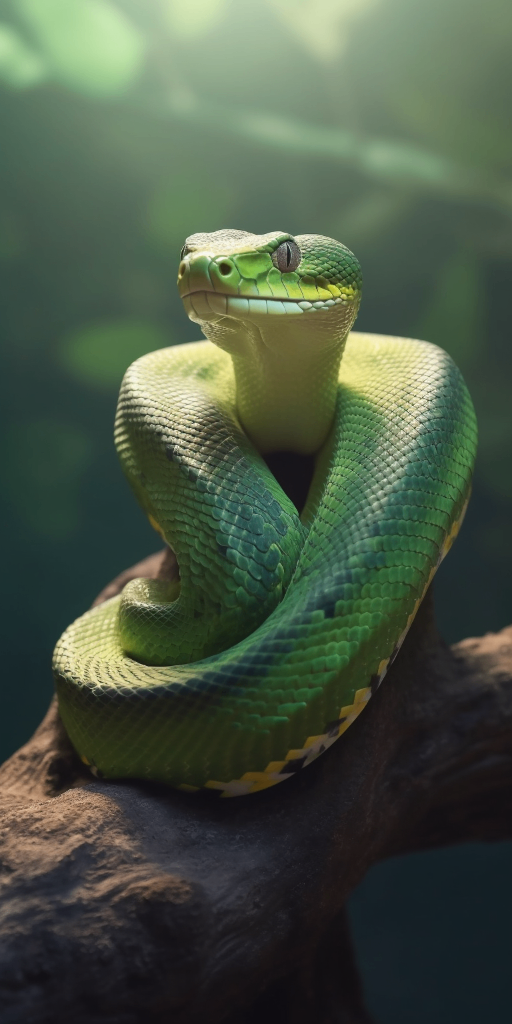The Green Tree Python
The Green Tree Python, also known as Morelia viridis, is a species of snake native to the tropical rainforests of New Guinea, Indonesia, and Australia. These arboreal snakes have a striking appearance, with a vibrant green coloration that helps them blend into the lush foliage of their natural habitat. Green Tree Pythons have a slender and elongated body, which allows them to navigate through the treetops with ease. They have large eyes and a prehensile tail, which they use to grip onto branches as they move. Despite their name, they are not true pythons but belong to their own genus, Morelia.

| Green Tree Python | |
|---|---|
| Size | Up to 6 feet (1.8 meters) |
| Weight | Up to 4.4 pounds (2 kilograms) |
| Speed | NA |
| Key Strength | Constriction |
| Biggest Weakness | Vulnerable to attacks on the head |
| Scientific Name | Chondropython viridis |
| Family | Pythonidae |
| Habitat | Rainforest |
| Geography | New Guinea, Indonesia, and Australia |
| Diet | Small mammals, birds, and reptiles |
| Lifespan | 15 years - 25 years |

The Green Tree Python
The Green Tree Python, also known as Morelia viridis, is a species of snake native to the tropical rainforests of New Guinea, Indonesia, and Australia. These arboreal snakes have a striking appearance, with a vibrant green coloration that helps them blend into the lush foliage of their natural habitat. Green Tree Pythons have a slender and elongated body, which allows them to navigate through the treetops with ease. They have large eyes and a prehensile tail, which they use to grip onto branches as they move. Despite their name, they are not true pythons but belong to their own genus, Morelia.
Fun Fact: Green Tree Pythons are born with bright yellow or red body coloration instead of green, which allows them to mimic the appearance of venomous snakes and warns potential predators of their potentially harmful nature.
| Green Tree Python | |
|---|---|
| Size | Up to 6 feet (1.8 meters) |
| Weight | Up to 4.4 pounds (2 kilograms) |
| Speed | NA |
| Key Strength | Constriction |
| Biggest Weakness | Vulnerable to attacks on the head |
| Scientific Name | Chondropython viridis |
| Family | Pythonidae |
| Habitat | Rainforest |
| Geography | New Guinea, Indonesia, and Australia |
| Diet | Small mammals, birds, and reptiles |
| Lifespan | 15 years - 25 years |
Green Tree Python Matchups
We use AI to simulate matchups between the Green Tree Python and other animals. Our simulation considers size, strength, and natural predatory behaviors to determine the most likely outcome.
Green Tree Python: Diet, Predators, Aggression, and Defensive Behaviors
What do Green Tree Pythons eat?
Green Tree Pythons primarily feed on small mammals, birds, and reptiles. In captivity, they are commonly fed mice, rats, and chicks. These snakes are ambush predators and rely on their excellent camouflage to blend in with their surroundings while waiting for prey to come within striking distance.
Do Green Tree Pythons have any predators?
In the wild, Green Tree Pythons may face threats from larger predators such as birds of prey, large snakes, and mammals. However, their cryptic coloration and ability to blend into their environment make them difficult to spot, providing them with some protection from predators.
Are Green Tree Pythons aggressive?
Green Tree Pythons are generally not aggressive towards humans but may exhibit defensive behaviors if they feel threatened or cornered. They are known to strike if they feel threatened but tend to be more docile when handled by experienced keepers.
Do Green Tree Pythons fight with other snakes?
Green Tree Pythons are solitary animals and do not typically engage in physical confrontations with other snakes. However, they may exhibit territorial behaviors and use body language, such as coiling and hissing, to establish dominance and defend their territories.
How do Green Tree Pythons defend themselves?
When threatened, Green Tree Pythons rely on their impressive camouflage to blend into their surroundings and avoid detection. If necessary, they may also bite or strike at a perceived threat as a form of defense. Additionally, they may inflate their bodies to appear larger and more intimidating to potential predators.
What is the biggest weakness of Green Tree Pythons in a fight?
Despite their agility and sharp teeth, Green Tree Pythons have relatively slender bodies compared to larger constrictor snakes. This means that they may be overpowered by larger predators if engaged in a physical confrontation. Additionally, their defensive strategy of camouflage and avoidance may not always be effective against determined predators.
Fun Fact: Unlike many snake species that lay eggs, Green Tree Pythons are oviparous, meaning they give birth to live young instead of laying eggs. The females incubate their eggs internally and give birth to fully-formed hatchlings, usually around six to eight in number.
Fun Fact: Green Tree Pythons have a specialized adaptation called "caudal luring," in which they wiggle their bright green tail to attract prey, such as small birds or mammals, which mistake it for a tasty worm or insect, only to fall victim to the waiting snake's ambush.















